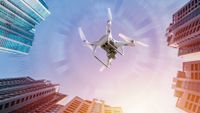Case Study:
"Benefits of Using Drones for Inspections"
Drones have revolutionized various industries by providing cost-effective and efficient means of inspection. The use of drones has made it possible to inspect areas that were previously inaccessible. Modern drones equipped with high-quality cameras can provide high-resolution images and videos of areas that would have been difficult or impossible to capture using traditional inspection methods.
Nowadays, drone inspections are being performed in almost every industry that requires visual inspections as part of its maintenance procedures. By using drones to collect visual data of the facility, inspectors avoid placing themselves in dangerous situations such as climbing on high buildings using traditional solutions including rope equipment.
There are several reasons why using drones for inspections can be better than using traditional methods. Here are some of them:
1. Reduced Equipment Costs:
Drones are typically less expensive than traditional inspection methods. For instance, using a drone to inspect a roof can be significantly less expensive than using scaffolding or hiring a cherry picker.
2. Increased Safety:
Drones can access hard-to-reach places, eliminating the need for people to work at heights, reducing the risk of accidents.
3. Reduced labor costs:
Drones can complete inspections with minimal human intervention, reducing the need for hiring manual workers.
4. Improved Speed and Efficiency:
Drones can cover large areas more quickly than traditional inspection methods, allowing for faster inspection times and reduced downtime. Drones can carry out inspections much faster than humans because they can move faster and more precisely. This saves time and increases efficiency.
5. Enhanced Accuracy and quality:
Drones are equipped with cameras and sensors that allow for accurate and detailed examination of objects. As a result, more precise inspection can be obtained providing detailed visual data that can be analyzed to identify issues and plan future repairs.
6. Access to remote locations:
Drones can be operated remotely, allowing for inspections to be conducted in dangerous or difficult-to-access areas without putting workers at risk and reducing the need for specialized equipment.
7. Real-Time Data Capture:
Drones can transmit data in real-time, allowing inspection teams to monitor the inspection process and make quick decisions regarding unpredicted issues.
8. Better data storage:
Drones can capture and store inspection data in digital format, making it easier to access and analyze.
9. Reduced environmental impact:
Drones are more environmentally friendly than traditional inspection methods, as they do not require to use large vehicles or equipment that consume fuel and produce emissions. Drones have a smaller carbon footprint compared to traditional inspection methods, making them a more sustainable option.
10. Flexibility:
Drones can be easily programmed to perform specific inspection tasks, making them more versatile and adaptable to changing inspection needs.
11. Mobility:
Drones are easy to transport and can be easily adapted to various tasks. Thanks to this, they can be used in many different places and in different conditions.
12. Improved customer experience:
Drones can provide customers with detailed inspection reports and images, helping to build trust and credibility.
In conclusion, the benefits of using drones for inspections in different industries are numerous. They provide a cost-effective and efficient means of inspecting areas that were previously inaccessible, and they can capture high-resolution images and videos of areas that would have been difficult or impossible to capture using traditional inspection methods. By using drones for inspections, industries can save time, reduce costs, and improve safety.
For German click icon below

